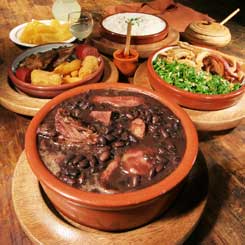The Brazilian cuisine is versatile. The Brazilian culture results from a mixture of European, Amerindian, African and Asian cultures and this is reflected in its food.
Brazil can be subdivided in 5 regions with their own distinct culinary traditions:

| 1-The Central West was opened up relatively recently and the cuisines of hunters, fishers and ranchers are gradually being replaced by the cuisines of other Brazilian regions. 2-The cuisine of the Northeast is heavily influenced by the African and Portuguese cuisines. |
| 3-The North is covered by the Amazon rainforest. Its biodiversity results in a unique availability of ingredients and the Amazon river provides abundant stocks of fish. |
| 4-In the Southeast lives the major share of the Brazilian population. When people talk about the Brazilian cuisine, they often mean the cuisine of this region. |
| 5-The cuisine of the South is heavily influenced by the cuisines of European immigrants and the abundance of high quality meat produced on the pampa's. |
Roast Suckling Pig
The southeast features delicious roast suckling pig and cracklings of fried pork skin.
 Feijoada is often called the national dish of Brazil. It is a delicious stew made of beans and various types of meat. It is eaten with white rice and side dishes like farofa and couve mineira. As feijoada contains a lot of fat, it is often eaten with slices of pineapple or orange. In many restaurants, feijoada is served daily at lunch time. Traditionally, every part of the pig was used for feijoada, including the tail and the trotter.
Feijoada is often called the national dish of Brazil. It is a delicious stew made of beans and various types of meat. It is eaten with white rice and side dishes like farofa and couve mineira. As feijoada contains a lot of fat, it is often eaten with slices of pineapple or orange. In many restaurants, feijoada is served daily at lunch time. Traditionally, every part of the pig was used for feijoada, including the tail and the trotter. Flan, or crème caramel, is one of the most common dessert dishes in the Latin world. Coming originally from the border area of France and Spain, this simple yet elegant dessert has spread in popularity as far as the Philippines and Japan.
Flan, or crème caramel, is one of the most common dessert dishes in the Latin world. Coming originally from the border area of France and Spain, this simple yet elegant dessert has spread in popularity as far as the Philippines and Japan.As always you must keep in mind that food safety standards and regulations are different for each country. You definitely want to make sure you know where your food and drink are coming from and that they were prepared safely. To do so in Brazil be sure to only eat at inspected and certified restaurants. If you decided to take your chances at any street vendors or non-regulated restaurants, beware! It may be cheap and taste delicious, but you may also PAY a much higher price with your health later.
Now would be the best time to remind you of some products you can take with you to ease your pain in the event "tummy trouble" does hit. Hopefully you wont need them at all.
Thank you to goodiesfirst.typepad.com, foodnetwork.com and donabrasil.com for the great info in this post.
No comments:
Post a Comment